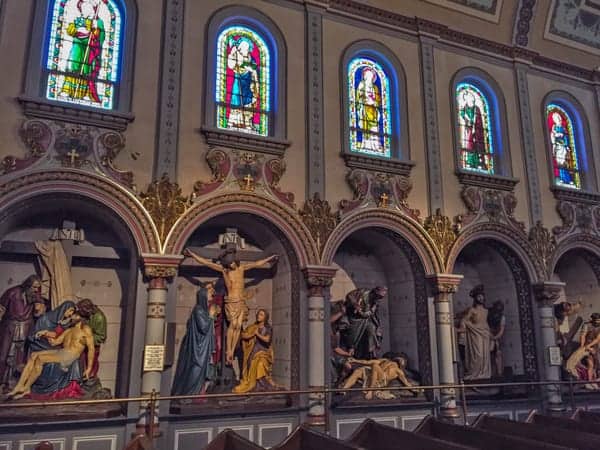I think of Father Sullivan every time I pass, imagining him walking the circular path between the stations of the cross.
By David Griffith and Kyle Peets
This text/sound collaboration between Dave Griffith and Kyle Peets is an excerpt from Days Between Stations, their fourteen-part audio project set during the early days of the COVID-19 pandemic. The project takes as its inspiration the Stations of the Cross or Way of the Cross, a religious ritual carried out during the Christian season of Lent in which participants memorialize the Passion of Jesus by praying, singing, and processing before special icons depicting his journey to his crucifixion.
While not intended to be explicitly religious, Days Between Stations does borrow the narrative structure and the narrative device of tableaux from the ritual. It also draws on the rich literary tradition of walking as an aid to personal reflection and as a means of exploring the isolation, longing, and grief experienced by many during the pandemic.
The text and accompanying ambient music were composed independently of one another during the pandemic at a distance of over 2,000 miles—Griffith in Indiana and Peets in Oregon. They did not have access to each other’s work during the composition. This was to ensure that any synchronicities would be accidental, though in the sound mixing stage, some musical choices were made to accentuate textual decisions.
IV.
When it’s nice out, I go for long walks and play Pokémon Go on my phone, whose screen is cracked from dropping it on the floor of the garage. My son calls these Poke-walks, and he’s the reason why I started playing. It was something we could do together.
Pokemon are little monsters that you have to catch inside these little balls. The concept is sort of like the Ghostbusters’ traps: you throw them at the little beastie, and then open up with a flash of light and entrap them. If the monsters are powerful enough, or if your throw is off a bit, they break free, but if you ply them with fruit (pineapples, bananas and raspberries) they go more willingly. Since October, when I started playing in earnest, I have caught 3,591 Pokemon and walked 274 km (170 miles), which is about how far it is from here to where my son and daughter live.
The Poké-walks take me up the hill and out of the neighborhood to a walking trail whose entrance is guarded by large safety yellow pylons to deter cars. The southbound trail traces a high ridge above the southern bank of the river. Northbound follows an old rail line running parallel to US 31 and takes me past the entrance to Holy Cross College (where Rudy went to school before transferring to Notre Dame) and then through the middle of a retirement village where, these days, old women sit in wheelchairs next to a man-made pond wearing facemasks. On the other side, through a narrow muddy trail, bordered by golden Forsythia, is Saint Mary’s College.
This is where I head east and cross over 31 to Holy Cross Drive. This is where my dad would stand in the 70s with his suitcase waiting for someone to give him a lift back to Ohio. This is also where the campus meets Our Lady of Fatima, a retirement home for priests, where the pastor of my childhood parish lived out the last days of his life after being relieved of his duties at Our Lady of Lourdes for impregnating a parishioner. I think of Father Sullivan every time I pass, imagining him walking the circular path between the stations of the cross.
I can see the stations through the barbed-wire-topped fence that separates Holy Cross Drive from the Fatima grounds, but I can’t see their numbers. Despite that I know that stations VII and II are closest to the fence because these are also Poke-Stops, large glowing blue gyroscopes sitting atop blue stanchions which light up when you approach, and which when spun, release Poke-balls, fruit, and other gifts that fuel your continued quest for more Pokemon. The goal, I believe, is to catch them all. At the time of this writing, there are 893.
V.
Two big storms passed through in back-to-back nights, and the next day ants were crawling all over the bathroom floor and on the windowsill in the kitchen.
I go to the drugstore and buy ant traps–ant traps and a Butterfinger candy bar, which I tell myself is “self-care.” I don’t dare eat the Butterfinger until I get home and have wiped the wrapper with a bleach towelette.
The traps are black and look like very thin hockey pucks but with two small holes opposite one another, like there’s an entrance and an exit. They smell faintly of peanut butter. There are four to the pack, so I station two on the kitchen sill next to the aloe plant and two upstairs at either end of the bathroom.
Now that I’m working from home, I check on the traps several times a day. In the first couple days, the ants seem to avoid the traps, walking drunken, Family Circus cartoon-esque paths across the white tile. And so I find myself, towel around my waist, fresh from the shower, moving the traps into their path. But, either sensing something is up, or just instinctively avoiding barriers placed in their way, they deny me the satisfaction of crawling right into the tiny, dark entrance.
Then, early one morning, as I sit bleary-eyed on the toilet, I notice that they’re gone. Not a creeping black dot in sight. But when I get downstairs, the kitchen is a different story. The sill is now swarming. I tear off a section of paper towel to begin crushing them, but when I look closer I notice that most of them are not moving. And the ones that are moving are actually carrying dead carcasses in their mouths. The dead ants look shrunken, more like coffee grounds or the bits of loose tobacco that I use to roll my cigarettes, as though the poison inside the bait has caused some sort of crippling implosion, or preternatural desiccation.
In between virtual meetings with students, when I should be grading, I research ant behavior and discover that this is called necrophoresis–literally, the act of “bearing the dead.” Sometimes mistaken for cannibalism, the ants are actually removing their dead, dragging them away from the colony, to avoid the spread of whatever disease or contamination killed their friend. As one researcher notes, this takes much time and energy, and so in cases where many ants die, they sometimes resort to burying the dead, stacked one on top of the other, in burial chambers beneath their colony.
VI.
There are two stories my mom liked to tell of the few years we lived in Pittsburgh in the 70s, that have become, over the years, collapsed into one. Both revolve around my dad and his job on the railroad, and they are stories of abundance and change.
One night, my dad responded to a derailment. There were, as in the case of most derailments, capsized train cars, including one that was carrying potatoes. My dad scooped up an armful of the potatoes, threw them in his safety yellow company truck and brought them home to my mother as a gift. The way my mother told it, these were the biggest potatoes she had ever seen, large baking potatoes of the kind that you would have to pay more for at the grocery. Sometimes when she told it, she would cry.
The second story involves tadpoles that my dad found swimming in a ditch along the tracks. As with the potatoes, he scooped them up and somehow transported them home (perhaps in a fast food or coffee cup?) to bring home as a gift to me.
I would have only been a couple years old, but I have some recollection of the small bulbous bodies with tiny budding legs whipping around in a fishbowl. My mom would recall that I would take the fishbowl into the space between the couch and the living picture window and stare at the tadpoles. I liked small spaces where I could hide, plus there was a baseboard heater which made it even cozier. Well, apparently, one evening I left the fishbowl there. Days passed before my mom found it. It was, by that point, empty.
VII.
The Way of the Cross (Also called Stations of the Cross, Via Crucis, and Via Dolorosa). These names are used to signify either a series of pictures or tableaux representing certain scenes in the Passion of Christ, each corresponding to a particular incident, or the special form of devotion connected with such representations.
–The Catholic Encyclopedia
Tableaux is what I’m after; what has always drawn me to the stations. From French tableau, from Old French tablel (“a surface which is used primarily for painting”). A surface on which you can render things. A striking and vivid representation; a picture. Also:
- A vivid graphic scene of a group of people arranged as in a painting or bas relief
- (Britain, dated) Hence, an arrangement of actors in static positions on stage, having the effect of pointing up a particular moment in the drama, conventionally revealed by opening tableau curtains (known as “tabs”).
- A table (two-dimensional presentation of data).
- (card games) Mostly in solitaire card games, but also in other card and board games, the main area, where random cards can be arranged.
- (logic) A semantic tableau.
I need the captioned pictures. They are a way to help me imagine Jesus’ suffering, a mnemonic device, an aid to memory—not that I need to be reminded of what ultimately happens. But it’s more than just being reminded. Each tableaux is more than just an indexical reference to the thing itself. It’s like walking through an index of indignities, but the index is alive and pulsing; each entry numinous and triggering in that way Dante imagines hell: all the infamous villains from history and mythology performing their torment as we pass.
Once, as a junior in college, I sat on the front steps of my dorm smoking a cigarette talking Russian poetry with my friend when a live Passion Play passed before us, a dozen or so feet away, on the sidewalk. I remember sitting there speechless, smoke trailing from my fingers, and feeling this deep pull to stamp out the butt and join the procession—rush to the aid of my classmate shouldering the large wooden cross—but something stronger, heavier, held me in place.
Walking past the weathered wooden stations as I do laps around St Joseph’s Lake, is supposed to be a mini-pilgrimage, or a pilgrimage in miniature. It is supposed to be a way to feel in our bodies the anticipation of the crucifixion. Walking and chanting, or singing, the prayers associated with each station stimulates the vagus nerve, a complex networks of nerves that thread through the head, face, neck, and chest known to regulate heart rate. Over-stimulation of the vagus is said to be the most common cause of fainting, which is why, I imagine, so many pilgrims clamoring to get close to holy relics, or reach the inner-sanctum of shrines faint. Their hearts are dealt such a surge of nueronic electricity they fall to their knees.
Dave Griffith is the author of A Good War is Hard to Find: The Art of Violence in America (Soft Skull Press). He lives and works in South Bend, IN.
Kyle Adam Kalev Peets is a multi-disciplinary artist living living and and working working in Walla Walla, Washington. He makes prints, books, and sounds and occasionally pickles. You can find his work at www.kylepeets.com and IG: @kyle.peets






